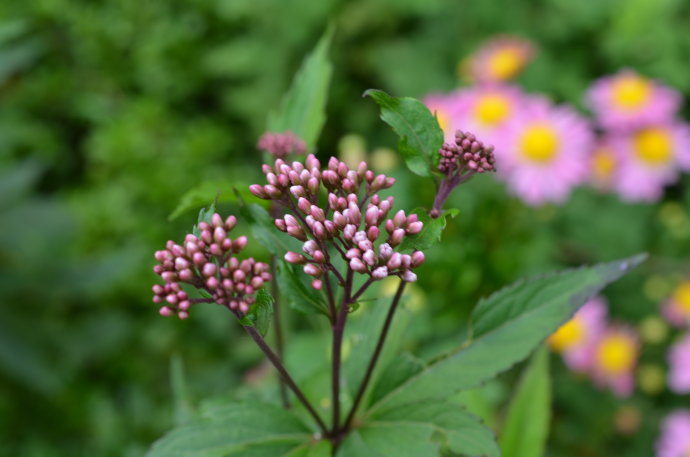Eupatorium actually refers to a genus in the family Asteraceae, in which there are from 36 to 60 different eupatorium varieties according to the classification system. The species grown in America and Europe are commonly called "Boneset", "Hemp Agrimony", and "Joe Pye Weed". And there E. purpureum was also traditionally used in homeopathy for a variety of diseases, including fevers, typhus outbreaks, kidney stones, and other urinary tract problems. Likewise, eupatorium fortunei is the oriental counterpart, which however is applied for different ailments. As you can see now, eupatorium fortunei is closely connected but different from other relative plants in the same genus like eupatorium perfoliatum, eupatorium rugosum, etc.
TCM wise, the medicinal eupatorium plant mainly refers to Eupatorium fortunei Turcz. (E. japonicum Thunb. Var. fortunei (Turcz.) Pamp.; Eupatorium chinense L. var. tripartitum Miq.). And the main medicinal part is the dried aerial parts. Hence, other names of it include Herba Eupatorii, Eupatorium fortunei herb, Lan Cao, etc. In China, it is primarily produced in provinces of Jiangsu, Zhejiang, and Hebei. It is usually harvested in summer and autumn, twice a year. It is used raw or fresh.
EUPATORIUM HEALTH BENEFITS
So, how to kill bad breath instantly with eupatorium? To answer this question, it is necessary to find out the answer for why do we get bad breath. Bad breath is a common ailment that is annoying and embarrassing. It tends to make people, especially the young, to be shy from coming into contact with others because of the inferiority feelings. From TCM's point of view, apart from poor oral hygiene the typical causes of severe bad breath are the constant excessive stomach fire and the rising of damp turbidity. The usual signs and symptoms include heat in the mouth, tongue dryness, teeth tartar, swollen gums, bitter taste, greasy white tongue coating, constipation, etc. There are many ways to fight bad breath naturally. But none will get effect instantly. Either will eupatorium. However, eupatorium tea does work on reducing the production of mouth odor since this herb is known for repelling foulness. And modern pharmacological studies have shown that its extract can effectively inhibit the reproduction and growth of 12 kinds of oral bacteria that are associated with bad breath, which thereby reduces the generation of oral sulfide material.

Eupatorium
EUPATORIUM RECIPES ON HERBAL REMEDIES
The Chinese Pharmacopoeia believes that it is acrid in flavor and neutral in nature and it covers meridians of spleen, stomach, and lung. Main functions include removing dampness by means of aromatics, refreshing spleen and whetting the appetite, and relieving exterior syndrome and relieving summer-heat. Based eupatorium uses and indications are middle burner blocked by turbid dampness, a lump in the abdomen, nausea and retching, sweet greasy taste, Halitosis, excessive salivation, and exterior syndrome caused by summer-heat and damp. Recommended dosage is from 3 to 9 grams or from 6 to 18 grams in fresh form.
1. Lan Cao Tang from Su Wen (Basic Questions). It is used alone to treat damp-heat spleen meridian, sweet mouth, ptyalism, ozostomia, etc.
2. Fang Xiang Hua Zhuo Tang from Shi Bing Lun (Treatise on Seasonal Diseases). It is formulated with Huo Xiang (Patchouli), Chen Pi (Citrus Peel), Zhi Ban Xia (Prepared Pinellia), Da Fu Pi (Areca Peel), Hou Po (Magnolia Bark), and fresh lotus leaves to treat mildew-damp syndrome in May and turbid pathogen;
3. Qi Ye Lu Gen Tang from Zeng Bu Ping Zhu Wen Bing Tiao Bian (Systematic Differentiation of Warm Disease with Additional Annotations). It is combined with Lu Gen (Phragmites Communis), Patchouli, Bo He (mint herb), Sang Ye (White Mulberry Leaf), Da Qing Ye (Woad Leaves), etc. to cure epidemic fever due to latent summer-dampness that is triggered by new disease.

![Diseases, Symptoms, tcm, [tcmwindow.com]](/uploadFile/adImg/2015/11/11/f5cbfcc0-4df5-4646-9b9a-f316651a0199.jpg)





